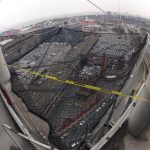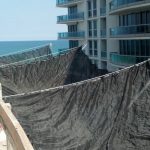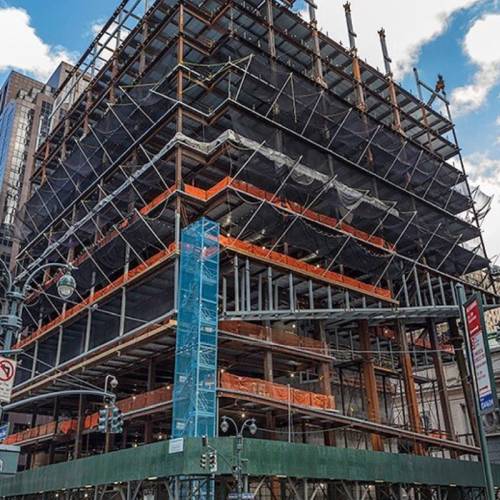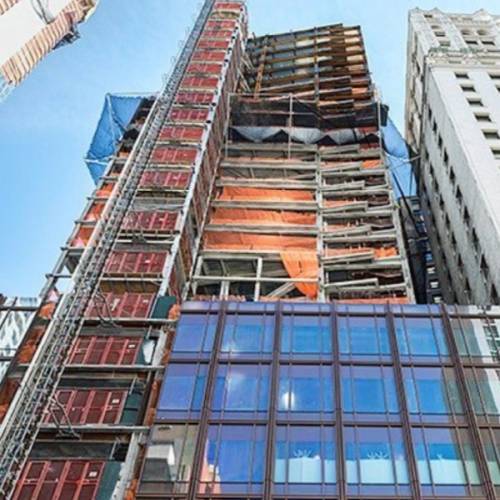Preventing Worker Falls in High-Rise Construction
Netting Systems Save Lives
 Horizontal Perimeter Netting (HPN) Systems save lives by catching a falling worker before they hit the ground. With its concentration of skyscrapers and crowded streets, it is no surprise that New York City has led the nation in requiring HPN systems on high-rise construction projects. Due to its close proximity to NYC, Fallproof has been a leader in the design, testing and supply of HPN systems and components for over 20 years.
Horizontal Perimeter Netting (HPN) Systems save lives by catching a falling worker before they hit the ground. With its concentration of skyscrapers and crowded streets, it is no surprise that New York City has led the nation in requiring HPN systems on high-rise construction projects. Due to its close proximity to NYC, Fallproof has been a leader in the design, testing and supply of HPN systems and components for over 20 years.
As the name implies, HPN is used to protect the perimeter of a building, and consists of netting cantilevered out from the building’s edge. This protects lives in two ways. First, if a worker falls off the edge, the netting is in place to prevent them from reaching ground. The nets cushion the fall by drawing together to provide a dynamic stopping distance rather than a hard impact. Unlike a trampoline, the system is engineered to absorb the energy rather than releasing it in the form of a recoil. The second way these systems protect lives is by catching dropped tools or construction debris that would otherwise fall to the sidewalks and streets below.
Department of Building Requirements for Netting
 The NYC Department of Building requires that netting be installed starting on the 6th floor or 75 ft. above the ground or adjoining roof level, whichever is applicable. The netting must be “jumped” or moved so that it is maintained no more than two stories below the stripping operation floor on concrete structures or the uppermost finished and walkable concrete floor on steel frame structures.
The NYC Department of Building requires that netting be installed starting on the 6th floor or 75 ft. above the ground or adjoining roof level, whichever is applicable. The netting must be “jumped” or moved so that it is maintained no more than two stories below the stripping operation floor on concrete structures or the uppermost finished and walkable concrete floor on steel frame structures.
In recent years netting has become a common requirement for high-rise construction projects throughout the US and Canada. While not always required by the local building code, owners, developers and insurance companies generally require them as a key component of a comprehensive site safety plan
Following are some of the key parts of a horizontal perimeter netting system:
- Engineered drawings showing placement of nets and poles, means of attachment, all system components, and other details.
- Netting: knotted 3 ½” to 4” mesh or the new knotless 2” to 2 ½” mesh now used in many construction applications across the US and Canada.
- Attachment hardware. Depending on the building, this could be slab grabbers, column or floor mounting brackets, or specially fabricated hardware.
- Outrigger poles to cantilever the system.
- Cables, clamps and other hardware to attach the netting to its support structure, keep it open and in place, and allow it to partially collapse in a controlled manner to absorb the impact of a fall.
Perimeter Netting – Rental and Purchase Options
Because every building has a different configuration, many companies prefer to rent rather than buy. Here at Fallproof we have a large variety of net sizes for rent or purchase for fall protection and perimeter systems on new construction. Our own trucks are used for deliveries in the NYC, Philadelphia and DC metro areas, and common carriers for deliveries throughout the US and Canada. We have the personnel to design a system for your new project and have that system engineered from a certified PE with signature and seal in your state. Our technicians are available as working trainers to ensure that the installation is completed correctly, on time, and on budget.
Below are two current projects where Fallproof has designed, engineered, and supplied perimeter netting systems.
One Vanderbilt, NYC
Trinity Place, NYC



